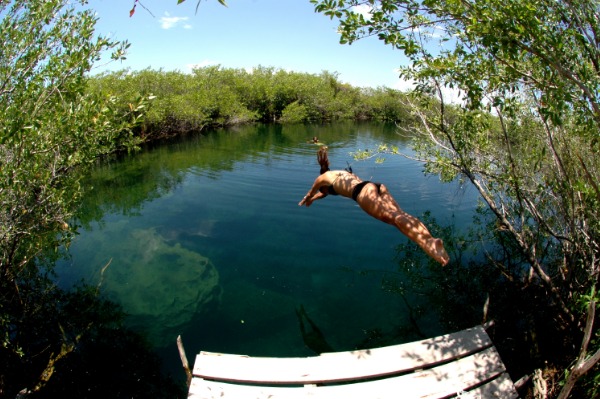A Magical Dive Into Nature

Cenotes are one of the “magical phenomenon” of the Mexican Caribbean, offering visitors travelling off the beaten path an awesome adventure.
Formed millions of years ago by sunken earth, these spaces filled with clear, fresh water to form underground rivers that were considered sacred by the ancient Mayans, now part of the world’s largest subterranean river system, the Grand Mayan Aquifer.
Cenotes are found throughout the Mexican Caribbean and vary in size, from young caverns, to semi-open cenotes exposed to weather, to open cenotes, expansive spaces that became uncovered over millions of years. Ancient Mayans revered cenotes as a connection to the underworld of Xibalba, where gods, spirits and supernatural beings reside in the afterlife. Artifacts found in cenotes today are believed to be offerings to the gods.
Dario Flota Ocampo, director of the Quintana Roo Tourism Board, says that: “Combining the wonders of nature with the mysticism of Mayan culture, cenotes are an unmissable experience for visitors of the Mexican Caribbean.”
For today’s travellers, the mysterious history of cenotes offers today’s visitors a thrilling adventure. Among the hundreds scattered across the region, the Mexican Caribbean boasts many of the cenotes that are easily accessible and open to visitors:
- Cenote Angelita (Tulum): An advanced dive and a truly unique cenote, owing to its stunning halocline (a cloud of hydrogen sulphide that divides fresh water and saltwater).
- Cenote Azul (Bacalar): The largest cenote in Bacalar and the only cenote near the Lagoon of Seven Colors. Its depth reaches almost 300 feet.
- Cenote Calavera (Tulum): With a depth of 50 feet, this open cenote is also known as the ‘Temple of Doom’ and named for its resemblance to a skull.
- Cenotes Zapote (Puerto Morelos): An ecological park located on the cenotes route in Puerto Morelos.
- Cenote Kin Ha (Puerto Morelos): A cave with an opening where light enters to reflect fun shapes throughout.
- Parque Tankah (Riviera Maya): A combination of nature and ancient Mayan mysticism, also boasting a lake.
- Cocodrilo Dorado (Chetumal): Located at the foot of a large rocky wall used for rappel, visitors can enjoy a pleasant view in a peaceful setting.
- Kantun Chi (Riviera Maya): An eco-park with five incredible cenotes and an impressive underground river.
- Dos Ojos (Riviera Maya): Two bodies of water joined by underground caverns, making this cenote ideal for guided snorkeling.
- Yalahau (Holbox): According to legend, divers in this cenote emerge feeling ten years younger.
- Cavernas de Jade – Cenote Chempita (Cozumel): Refreshing natural waters with incredible stalactite formations.
Cenotes also have a rich history of health and wellness in the Mayan community. Their waters were believed to purify and protect the soul thus cenotes have served as the site for traditional rituals. In fact, the Mayans believed that cenotes held powerful suhuy ha’, or virgin water, an origin of life.
In addition, for centuries these aquifers served as a main source of cold, naturally filtered water to nearby communities. Various minerals that filtered through the water over millions of years have created a backdrop of impressive stalagmites and stalactites. This cool, damp climate also homes endangered species of flora and fauna. These diverse elements together create a picturesque setting of jaw-dropping beauty.
For more, go to www.mexicancaribbean.travel .


